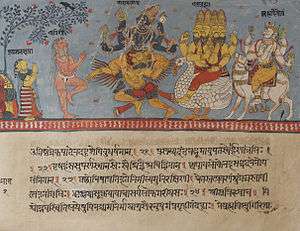Vahana
Vahana (Sanskrit: वाहन, Vāhana, literally "that which carries, that which pulls") denotes the being, typically an animal or mythical entity, a particular Hindu deity is said to use as a vehicle. In this capacity, the vahana is often called the deity's "mount". Upon the partnership between the deity and his vahana is woven much iconography and mythology. Deities are often depicted riding (or simply mounted upon) the vahana. Other times, the vahana is depicted at the deity's side or symbolically represented as a divine attribute. The vahana may be considered an accoutrement[1] of the deity: though the vahana may act independently, they are still functionally emblematic or even syntagmatic of their "rider". The deity may be seen sitting or standing on the vahana. They may be sitting on a small platform called a howdah, or riding on a saddle or bareback.[2] Vah in Sanskrit means to ride along the land.

Symbolism
In Hindu iconography, positive aspects of the vehicle are often emblematic of the deity that it carries. Nandi the bull, vehicle of Shiva, represents strength and virility. Dinka the mouse, vehicle of Ganesha, represents speed and sharpness. Parvani the peacock, vehicle of Skanda, represents splendor and majesty. The hamsa, vehicle of Saraswati, represents wisdom, grace and beauty.
However, the vehicle animal also symbolizes the evil forces over which the deity dominates. Mounted on Parvani, Skanda reins in the peacock's vanity. Seated on Dinka the rat (Mushika), Ganesh crushes useless thoughts, which multiply like rats in the dark. Shani, protector of property, has a vulture, raven or crow in which he represses thieving tendencies. Under Shani's influence, the vahana can make even malevolent events bring hope.
Origin folklore
The vehicle of a deity can vary according to the source, the time, and the place. In popular tradition, the origin of each vehicle is told in thousands of different ways. Three examples:
- While the god Ganesha was still a child, a giant mouse began to terrorize all his friends. Ganesha trapped him with his lasso and made him his mount. Mushika was originally a gandharva, or celestial musician. After absent mindedly walking over the feet of a rishi (sage) named Vamadeva, Mushika was cursed and transformed into a mouse. However, after the rishi recovered his temper, he promised Mushika that one day, the gods themselves would bow down before him. The prophecy was fulfilled when the mouse became the vahana of Ganesha.
- Before becoming the vehicle of Shiva, Nandi was a deity called Nandikeshvara, lord of joy and master of music and dance. Then, without warning, his name and his functions were transferred to the aspect of Shiva known as the deity Nataraja. From half-man, half-bull, he became simply a bull. Since that time, he has watched over each of Shiva's temples, always looking towards him.
- Kartikeya, the war-god known as Murugan in Southern India, is also mounted on a peacock. This peacock was originally a demon called Surapadma, while the rooster was called the angel[Krichi]. After provoking Murugan in combat, the demon repented at the moment his lance descended upon him. He took the form of a tree and began to pray. The tree was cut in two. From one half, Murugan pulled a rooster, which he made his emblem, and from the other, a peacock, which he made his mount. In another version, Karthikeya was born to kill the demon, Tarakasura. He was raised by the Krittikas and led the divine armies when he was 6 days old. It is said that after defeating Tarakasura, the god forgave him and transformed him into his ride, the peacock.
Origin theories
The vahana and deity to which they support are in a reciprocal relationship. Vahana serve and are served in turn by those who engage them. Many vahana may also have divine powers or a divine history of their own. Case in point, the aforementioned Nataraja story, represents a conflation of Hindu gods with local gods, syncretizing their mythos as their territories began to overlap. According to one source, "they could be a synthesis between Vedic deities and autochthonous Dravidian totemic deities.
Compared to other belief systems
The animal correspondences of Hindu vehicles are not consistent with Greek and Roman mythology, or other belief systems which may tie a particular animal to a particular deity. For example, the goddess Lakshmi of the Hindus has elephants, or an owl, or (a rare instance of a non-animal vehicle) the lotus blossom as her vehicle. The goddess Athena of ancient Greece also had an owl as her emblematic familiar, but the meanings invested in the owls by the two different belief systems are not the same, nor are the two goddesses themselves similar, despite their mutual identification with owls.
Lakshmi is, among other things, primarily the goddess of wealth, and her owl is a warning against distrust and isolationism, even selfishness. Athena, though also a goddess of prosperity, is primarily the goddess of wisdom, and her owl symbolizes secret knowledge and scholarship. Perhaps due to their shared geography, the Greco-Roman interpretation is paralleled in Roman Catholic iconography, in which St. Jerome, most famed for editing the New Testament, is often (though not always) depicted with an owl as a symbol of wisdom and scholarship.[3] Depending on the tribe, Native American religious iconography attributes a wide range of attributes to the owl, both positive and negative, as do the Ainu and Russian cultures, but none parallel the Hindu attributes assigned to the owl as Lakshmi's divine vehicle.[4]
Some hold that similar analyses could be performed cross-culturally for any of the other Hindu divine vehicles, and in each case, any parallels with the values assigned to animal totems in other cultures are likely to be either coincidence, or inevitable (as in linking bulls to virility), rather than evidence of parallel development. In dialectic, this is countered by the retort that each totem or vahana, as an aspect of ishta-devata (or an ishta-devata or asura in its own right), has innumerable ineffable teachings, insights and spiritual wisdom; comparative analysis yields benefit, though knowledge and understanding is not served by collapsing their qualities into homogenous signification.
List of God vehicles
| Vahana | Deities associated | Image |
|---|---|---|
| Mouse named Mooshakraja | Ganesha (pictured) | 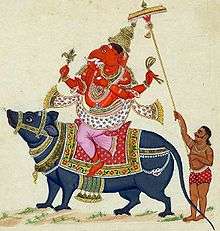 |
| Horse | Kalki, Shukra, Swaminarayan(female horse named "Manki"), Ayyappan, Revanta, Chandra (chariot of 10 white horses), Indra (chariot pulled by a horse named Uchchaihshravas - pictured), Surya (chariot pulled by seven horses or a seven-headed horse), Vali, Khandoba, Ramdev Pir. | 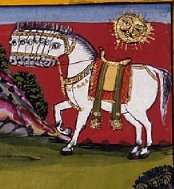 |
| Garuda (pictured) | Vishnu, Krishna, Vaishnavi. | 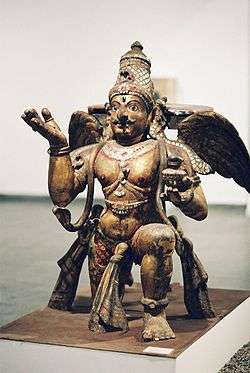 |
| Ram | Agni (pictured), Mangala |  |
| Nandi (pictured) | Shiva, Maheshvari | |
| Peacock | Kartikeya (peacock named Parvani, pictured),. Accessed August 10, 2007.</ref> Kaumari | 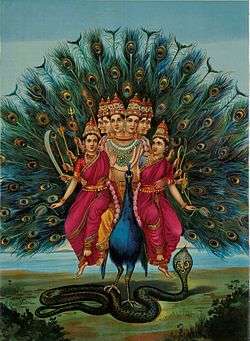 |
| Dog | Bhairava (pictured with dog as Vahana), Hadkai Maa, Svapathi (Shiva) |  |
| Hamsa (Swan) | Brahma (pictured) named Hanskumara,[2] Brahmani, Saraswati(Savitri), Gayatri, Vishvakarman | 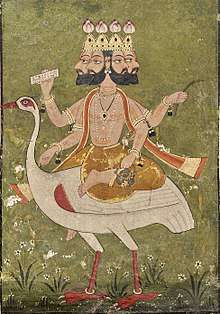 |
| Makara | Ganga, Varuna (pictured), Kama, Khodiyar, Narmada |  |
| Lion (a form of the Vahana, Manasthala) | Durga (pictured), | |
| Lion (a form of the vahana) | Parvati (lion named Dawon), Budh (planet Mercury in vedic astrology), Rahu (Neptune), Mariamman, karni mata, Jagaddhatri (pictured). | 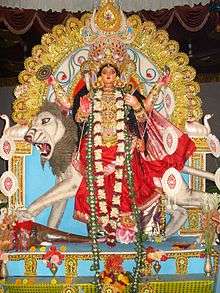 |
| Elephant | Indra (elephant named Airavata, pictured), Lakshmi, Bhumi, Prithvi, Indrani, Brihaspati. | 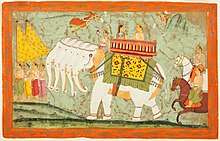 |
| Parrot | Kama (named Sukha) |  |
| Antelope | Chandra (chariot of), Vayu (pictured) |  |
| Water buffalo | Yama (buffalo named Paundraka, pictured), Vihot Mata | 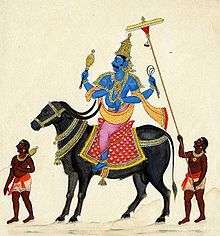 |
| Cat[5] | Shashthi | 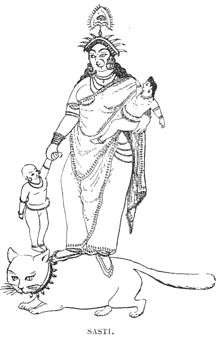 |
| Donkey | Kaalratri, Shitala (pictured), Kali (demon) |  |
| Owl | Lakshmi[2][6] (pictured with the owl on her left, named Alooka), Chamunda | |
| Vulture | Ketu (south node in vedic astrology) | |
| Crow | Shani (planet Saturn in vedic astrology), Alakshmi, Dhumavati (pictured) | |
| Tortoise | Yamuna (pictured standing on it), Varuna | |
| Cockerel | Bahuchara Mata | 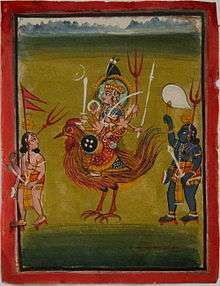 |
| Cow | Ushas (chariot of seven cows) | - |
| Snake | Kamakhya, Manasa (picture) |  |
| Pigeon | Rati | - |
| Rhinoceros | Dhavdi | - |
| Goats | Pushan (chariot of), Meladi Maa | - |
| Crocodile | Khodiyar , Ganga | |
| Camel | Momai Maa (aka Dashaa Maa), Ushtravahini Devi | - |
| Man | Daksha | |
These correspondences are not always consistent. Ganesh, for example, is sometimes shown with a peacock as his vehicle, although a peacock is the customary vehicle of his brother Kartikeya (also known as Murugan, Subramanya, Skanda and other names) as well as the vehicle sometimes associated with the goddess Saraswati. Even more rarely, the elephant-headed Ganesh may be seen riding another elephant, or a lion, or a many-headed serpent.[7]
As the vahana, the mount or vehicle of a deity, serves the function of doubling a God's or Goddess' powers. The vahana also represents the devotee's mind which allows the deity to guide the devotee. Durga the warrioress could not have destroyed the demon Mahishasura without the aid of her vehicle, lion, which was given by her father Himalaya, for the stated purpose. Lakshmi, goddess of fortune, dispenses both material and spiritual riches from her mount, Uluka the owl. Ganesh, remover of obstacles, cannot go everywhere despite his elephant-like strength. However, his vehicle, Mushika the mouse, who can crawl into the smallest crevice or Akhuketana the rat, who can survive just about anywhere, can assist Ganesh to overcome the greatest obstacles.
Notes
- Accoutrement = "that which accompanies".
- Glossary: Vahana. Undated. Accessed August 10, 2007.
- The Collection: St. Jerome Archived 2012-10-22 at the Wayback Machine, gallery of the religious art collection of New Mexico State University, with explanations. Accessed August 10, 2007.
- Owl and Mythology, p. 3. Accessed August 10, 2007.
- Margaret Stutley's The Illustrated Dictionary of Hindu Iconography , p. 127
- Hindu Devotion: Lakshmi. Accessed August 10, 2007.
- Forms of Ganesh: The Mouse Mount and Other Ganesh Mounts Archived 2007-03-02 at the Wayback Machine. Accessed August 10, 2007.
External links
| Wikimedia Commons has media related to Vahana. |
| Wikiversity has learning resources about Yoga oracle#129 Power Animal |
- Holy Vehicles, an illustrated list. Accessed August 10, 2007.
- Karthikeyan / Subramanian Riding His Peacock Accessed August 10, 2007.
- Hindu Deities and Their Vehicles, a partial list at About.Com. Accessed August 10, 2007.
- Symbolism of the Vehicles of Gods and Goddesses. Accessed August 10, 2007.
